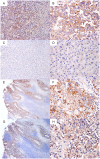Identification and characterization of tropomyosin 3 associated with granulin-epithelin precursor in human hepatocellular carcinoma
- PMID: 22792281
- PMCID: PMC3391266
- DOI: 10.1371/journal.pone.0040324
Identification and characterization of tropomyosin 3 associated with granulin-epithelin precursor in human hepatocellular carcinoma
Abstract
Background and aim: Granulin-epithelin precursor (GEP) has previously been reported to control cancer growth, invasion, chemo-resistance, and served as novel therapeutic target for cancer treatment. However, the nature and characteristics of GEP interacting partner remain unclear. The present study aims to identify and characterize the novel predominant interacting partner of GEP using co-immunoprecipitation and mass spectrometry.
Methods and results: Specific anti-GEP monoclonal antibody was used to capture GEP and its interacting partner from the protein extract of the liver cancer cells Hep3B. The precipitated proteins were analyzed by SDS-PAGE, followed by mass spectrometry and the protein identity was demonstrated to be tropomyosin 3 (TPM3). The interaction has been validated in additional cell models using anti-TPM3 antibody and immunoblot to confirm GEP as the interacting partner. GEP and TPM3 expressions were then examined by real-time quantitative RT-PCR in clinical samples, and their transcript levels were significantly correlated. Elevated TPM3 levels were observed in liver cancer compared with the adjacent non-tumorous liver, and patients with elevated TPM3 levels were shown to have poor recurrence-free survival. Protein expression of GEP and TPM3 was observed only in the cytoplasm of liver cancer cells by immunohistochemical staining.
Conclusions: TPM3 is an interacting partner of GEP and may play an important role in hepatocarcinogenesis.
Conflict of interest statement
Figures




Similar articles
-
Granulin-epithelin precursor interacts with 78-kDa glucose-regulated protein in hepatocellular carcinoma.BMC Cancer. 2017 Jun 10;17(1):409. doi: 10.1186/s12885-017-3399-x. BMC Cancer. 2017. PMID: 28601093 Free PMC article.
-
Granulin-epithelin precursor is an oncofetal protein defining hepatic cancer stem cells.PLoS One. 2011;6(12):e28246. doi: 10.1371/journal.pone.0028246. Epub 2011 Dec 16. PLoS One. 2011. PMID: 22194816 Free PMC article.
-
Hepatic cancer stem cell marker granulin-epithelin precursor and β-catenin expression associate with recurrence in hepatocellular carcinoma.Oncotarget. 2016 Apr 19;7(16):21644-57. doi: 10.18632/oncotarget.7803. Oncotarget. 2016. PMID: 26942873 Free PMC article.
-
Granulin-epithelin precursor overexpression promotes growth and invasion of hepatocellular carcinoma.Clin Cancer Res. 2004 Nov 15;10(22):7629-36. doi: 10.1158/1078-0432.CCR-04-0960. Clin Cancer Res. 2004. PMID: 15569995
-
Mechanisms of tropomyosin 3 in the development of malignant tumors.Heliyon. 2024 Aug 2;10(15):e35723. doi: 10.1016/j.heliyon.2024.e35723. eCollection 2024 Aug 15. Heliyon. 2024. PMID: 39170461 Free PMC article. Review.
Cited by
-
Progranulinopathy: A diverse realm of disorders linked to progranulin imbalances.Cytokine Growth Factor Rev. 2024 Apr;76:142-159. doi: 10.1016/j.cytogfr.2023.11.001. Epub 2023 Nov 11. Cytokine Growth Factor Rev. 2024. PMID: 37981505 Free PMC article. Review.
-
Progranulin: A promising biomarker and therapeutic target for fibrotic diseases.Acta Pharm Sin B. 2024 Aug;14(8):3312-3326. doi: 10.1016/j.apsb.2024.04.026. Epub 2024 May 6. Acta Pharm Sin B. 2024. PMID: 39220875 Free PMC article. Review.
-
The prognostic value of TPM1-4 in hepatocellular carcinoma.Cancer Med. 2022 Jan;11(2):433-446. doi: 10.1002/cam4.4453. Epub 2021 Nov 30. Cancer Med. 2022. PMID: 34850589 Free PMC article.
-
Actin binding proteins: their ups and downs in metastatic life.Cell Adh Migr. 2013 Mar-Apr;7(2):199-213. doi: 10.4161/cam.23176. Epub 2013 Jan 9. Cell Adh Migr. 2013. PMID: 23302954 Free PMC article. Review.
-
Comparative Proteomic Study Shows the Expression of Hint-1 in Pituitary Adenomas.Diagnostics (Basel). 2021 Feb 17;11(2):330. doi: 10.3390/diagnostics11020330. Diagnostics (Basel). 2021. PMID: 33671384 Free PMC article.
References
-
- El-Serag HB, Rudolph KL. Hepatocellular carcinoma: epidemiology and molecular carcinogenesis. Gastroenterology. 2007;132:2557–2576. - PubMed
-
- El-Serag HB, Marrero JA, Rudolph L, Reddy KR. Diagnosis and treatment of hepatocellular carcinoma. Gastroenterology. 2008;134:1752–1763. - PubMed
-
- Wysocki PJ. Targeted therapy of hepatocellular cancer. Expert Opin Investig Drugs. 2010;19:265–274. - PubMed
-
- Cheung ST, Chen X, Guan XY, Wong SY, Tai LS, et al. Identify metastasis-associated genes in hepatocellular carcinoma through clonality delineation for multinodular tumor. Cancer Res. 2002;62:4711–4721. - PubMed
Publication types
MeSH terms
Substances
LinkOut - more resources
Full Text Sources
Medical
Miscellaneous

